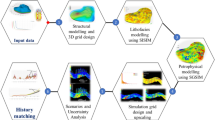Abstract
This paper describes a novel approach to modeling braided stream fluvial reservoirs. The approach is based on a hierarchical set of coordinate transformations involving relative straingraphic coordinates, translations, rotations, and straightening functions. The emphasis is placed on geologically sound geometric concepts and realistically-attainable conditioning statistics including areal and vertical facies proportions. Modeling proceeds in a hierarchical fashion, that is (1) a stratigraphic coordinate system is established for each reservoir layer, (2) a number of channel complexes are positioned within each layer, and then (3) channels are positioned within each channel complex. The geometric specification of each sand-filled channel within the background of floodplain shales is a marked point process. Each channel is marked with a starting location, size parameters, and sinuosity parameters. We present the hierarchy of eight coordinate transformations, introduce an analytical expression for the channel cross-section shape, describe the simulation algorithm, and demonstrate how the realizations are made to honor local conditioning data from wells and global conditioning data such as areal and vertical proportions.
Similar content being viewed by others
References
Bridge, J., and Leeder, M., 1979, A simulation model of alluvial stratigraphy: Sedimentology. v. 26, no. 5, p. 617–644.
Clemensten, R., and others, 1990, A computer program for evaluation of fluvial reservoirs,in Buller, A. T., and others, eds., North Sea Oil and Gas Reservoirs II: Graham and Trotman, London, p. 373–385.
Deutsch, C., and Cockerham, P., 1994, Practical considerations in the application of simulated annealing to stochastic simulation: Math. Geology, v. 26, no. 1, p. 67–82.
Deutsch, C., and Journel, A., 1992, GSLIB: Geostatistical Software Library and user's guide: Oxford Univ. Press, New York, 340 p.
Henriquez, A., and others, 1990, Characterization of fluvial sedimentology for reservoir simulation modeling: Soc. Petroleum Engineers Formation Evaluation Jour., v. 5, no. 3, p. 211–216.
Mackey, S., and Bridge, J., 1992, A revised FORTRAN program to simulate alluvial stratigraphy. Computers & Geosciences, v. 18, no. 2/3, p. 119–181.
Tyler, K., Henriquez, A., and Svanes, T., 1995, Modeling heterogeneities in fluvial domains: a review on the influence on production profile,in Yarus, J., and Chambers, R., eds., Stochastic modeling and geostatistics: principles, methods, and case studies: Am. Assoc. Petroleum Geologists Computer Applications in Geology No. 3, p. 77–89.
VanWagoner, J., Mitchum, R., Campion, K., and Rahmanian, V., 1990, Siliciclastic sequence stratigraphy in well logs, cores, and outcrops: Concepts for high-resolution correlation of time facies: American Association of Petroleum Geologists, Tulsa, Oklahoma, 55 p.
Author information
Authors and Affiliations
Rights and permissions
About this article
Cite this article
Deutsch, C.V., Wang, L. Hierarchical object-based stochastic modeling of fluvial reservoirs. Math Geol 28, 857–880 (1996). https://doi.org/10.1007/BF02066005
Received:
Accepted:
Issue Date:
DOI: https://doi.org/10.1007/BF02066005




